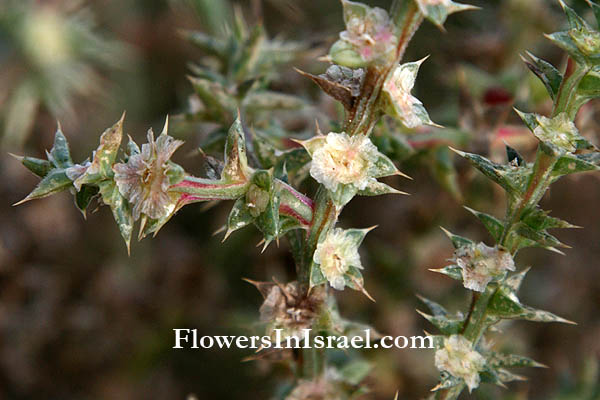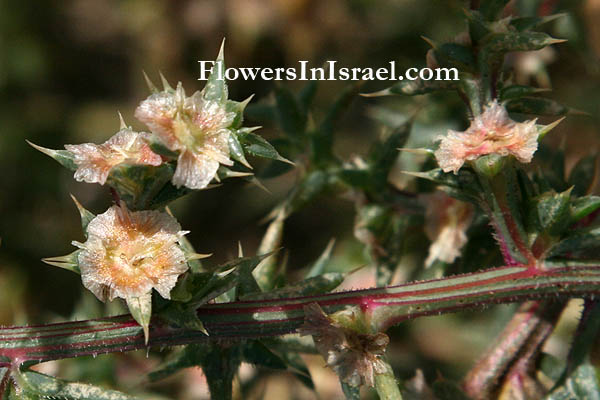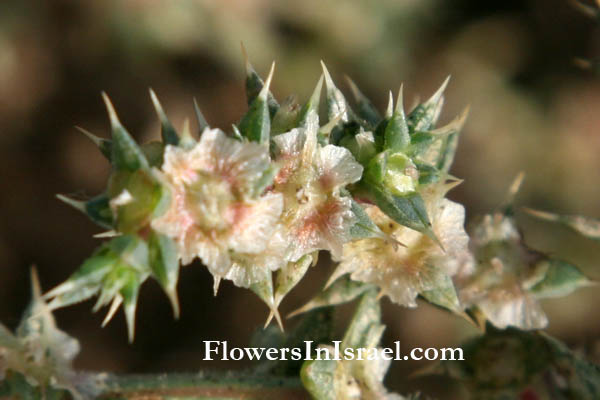Prickly glasswort, Hebrew: מלחית אשלגנית, Arabic: شنان
Although you wash yourself with soda
and use an abundance of soap,
the stain of your guilt is still before me,"
declares the Sovereign LORD.
Jeremiah 2:22
| Scientific name: | Salsola kali L. | |
| Common name: | Russian thistle, Prickly saltwort, Prickly glasswort | |
| Hebrew name: | מלחית אשלגנית | |
| Arabic name: | شنان | |
| Family: | Chenopodiaceae, סלקיים |

|
| Life form: | Therophyte, annual | |
| Leaves: | Alternate, cylindrical or terete, succulent, spinescent | |
| Flowers: | Green; hermaphrodite; pollinated by wind | |
| Flowering Period: | July, August, September, October | |
| Habitat: | Shrub-steppes, Desert, Salty habitats, Mediterranean strand | |
| Distribution: | Mediterranean Woodlands and Shrublands, Semi-steppe shrublands, Shrub-steppes, Deserts and extreme deserts | |
| Chorotype: | pluriregional; boreal-tropical | |
| Summer shedding: | Ephemeral |

Derivation of the botanical name: Salsola, Latin salsus, salty. kali, from the Arabic al qaly, from Kali, an area of Saudi Arabia called the Rub al-Kali or Rub al-Khali, the "Empty Quarter." It is likely that alkaline plants grow there. The Hebrew name: מלחית, milchit, saltwort, salsola, formed from מלח, melach (=salt), with suffix ית, it.
Salsola kali can cause dermatitis in persons who come into direct contact with it. The dermatitis appears to be due only to mechanical irritation from plant floral bracts, which pierce the skin and stimulate an urticarial reaction. The winged, 2 mm grey to brownish-yellow seeds are cone-shaped coiled utricles with the coiled embryo visible, and are held in the leaf axils until after plant death. After the seeds mature in late autumn, the plant stem separates from the root, becoming “tumbleweed”. The plant is then blown by wind. Seeds fall to the ground as the plant tumbles, and further dispersal is accomplished when wind scatters the winged seeds. These plants are prolific seeders. Even if I washed myself with soap and my hands with washing soda, אם-התרחצתי במו-שלג והזכותי בבר כפי; איוב ט Job 9:30 Numerous plants capable of yielding alkalies exist in Israel. The word בֹּר (bor, “lye, potash”) refers to the ingredient used to make the hands pure or clean. It has the same meaning as בֹּרִית (borit), the alkali or soda made from the ashes of certain plants. Salsola kali (Hubeibeh, Arabic: el-kuli, el qali, [the origin of English alkali]) probably the vegetable lye, is one of the several plants, capable of yielding alkalies and burned to make soap. Soap was made by mixing olive oil in large cauldrons with an aqueous solution of an alkali - soda ash. Originally the soda ash was obtained from the salsola kali. But recently this has been replaced by industrially produced soda ash. On account of its high alkali content, the plant has also been used as a a fluxing agent in glass making. A fluxing agent is a material that serves to lower the melting point of the glass, thus making it possible to melt glass in wood burning oven made of clay. Venetian glass during the Renaissance used "Levant soda ash", called Alume catino. This soda ash was created by burning the Salsola soda and the Salsola kali plants that grew in the Levantine ( the eastern part of the Mediterranean) region. 
|